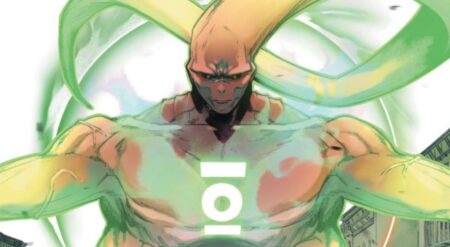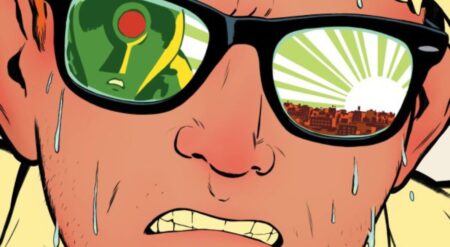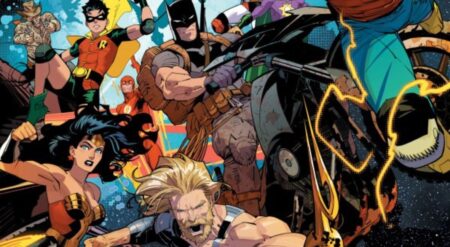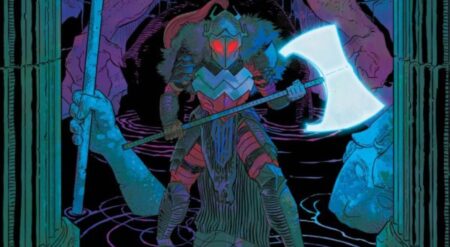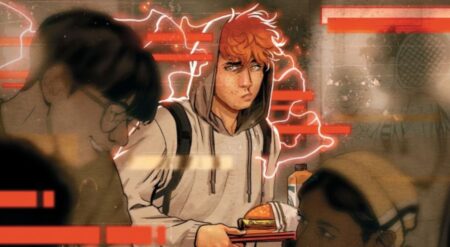Batman #151 is published by DC Comics. It is written by Chip Zdarsky, with pencils by Mike Hawthorne, inks by Adriano Di Benedetto, colors by Romulo Fajardo Jr, and letters by Clayton Cowles. There is a backup story written by Tini Howard, art by Marianna Ignazzi, colors by Giovanna Niro, and letters by Cowles. This is part of the Absolute Power event. In Batman #151, Batman and Catwoman head to the island of Okinawa, where Amanda Waller has hidden a Mother Box. But Waller has sent her Suicide Squad to bring the Bat and Cat down.
Batman #151 takes a detour away from the chaos unleashed in America, but the influence of Absolute Power is never far behind. The opening part of the book is a calm piece of espionage as Bruce and Selina enter Okinawa in disguise. The pace is pleasantly methodical as the plan is executed, but Zdarksy rapidly lays out where it will go wrong. As the heroes traverse the island, it merely becomes a matter of anticipation of when the two forces will meet. And when they do, the pace is ratcheted up several notches.
Zdarsky highlights how outnumbered and outgunned Batman and Catwoman are, adding weight and suspense to the confrontation. The fight moves in waves, and the structure splits. The heist of the Mother Box is already immensely dangerous and nearly impossible.
The location change is also an excellent deviation from a standard Batman comic. Bruce is entirely out of his comfort zone in Okinawa. There aren’t buildings to grapple from or dark alleys to disappear into. But he can adapt. Batman #151 may not have many jaw-dropping surprises in its plot, but it is still an exciting adventure.
Zdarsky includes excellent dialogue within the book, within both the word balloons and caption boxes. Batman and Catwoman narrate the most action-packed parts of the whole issue, detailing the adventure in a way that makes it effortless to follow along. He analyses everything in a brusque manner, quickly and decisively. This comes into play most effectively in the fight between Batman and the Suicide Squad. This new team was recently assembled and filled with different enemies.
Zdarsky brilliantly explains what’s happening, giving insight into Bruce Wayne’s thought processes. It is also more honest than his speech patterns, getting exasperated when a tactic fails. Catwoman has a mindset similar to Bruce’s, having worked alongside him for years. The Suicide Squad speaks briefly but is drawn into physical conflict with Batman before they can say too much. However, in these initial interactions, their personalities come through.
The art is phenomenal. Hawthorne and Di Benedetto create a beautiful location, capturing how Okinawa could not be further removed from Gotham. The mountains in the background and greenery in the foreground make a stunning backdrop for Batman and Catwoman’s heist.
The opening scene features some excellent disguises for Bruce and Selina, completely hiding their real identities. When Batman’s costume does appear, it sports adornments that are explained in Absolute Power #2. These are subtly added to the Batsuit, interesting without being overbearing.
The Suicide Squad lineup is fascinating because their designs are all completely unique. Deadeye, Waller’s nephew, is like a soldier of the future. Black Alice is a tiny goth girl. Clock King looks like a disturbing maths teacher. And Bizarro is… Bizarro. This creates different moves and visuals for each confrontation when Batman and Catwoman face off with them. Where some are fist fights, others are dodging mystical blasts. The fight scenes are incredibly fun, radiating energy.
The colors are attractive because Batman has to be presented in the light for a change. Bruce is placed in a blend of green and yellows in the open air, eliminating his stealth capabilities. All the characters are prominent in the background, coated in black, red, or blue costumes that make it easy to stand out. The lettering fits the characters’ voices and the situation’s tone without sacrificing legibility. The change in caption boxes Batman and Catwoman’s separate voices leaves them distinct and effortless to switch between them.
The backup story sees Harley Quinn track down and confront Riddler, pitting a villain and a former villain against each other. It’s an intense standoff highlighting Harley’s intelligence and strength, sometimes far too powerful for Edward Nygma. The art and the colors are fascinating, with a fierce red covering most of the story and highlighting the danger of the situation.
Batman #151 is an excellent tie-in. The issue excels because it is not set in Gotham, highlighting how Batman is an exceptional fighter and hero in any location. The artists gorgeously present Okinawa and set the stage for an extremely satisfying brawl between heroes and villains. The presence of those villains makes this tie-in stand out compared to the others within the crossover.
The Amazo robots are terrifying and fantastic, but a sense of inevitability comes with them. They are invincible machines with the sole focus of putting heroes down. The Suicide Squad is dangerous, but Batman at least stands a chance. It leads to the generation of an astounding battle between the teams and an intensity that increases with every step the Bat and Cat make toward the Mother Box.
Batman #151 is available where comics are sold.
Batman #151
-
Rating
TL;DR
Batman #151 is an excellent tie-in. The issue excels because it is not set in Gotham, highlighting how Batman is an exceptional fighter and hero in any location.


